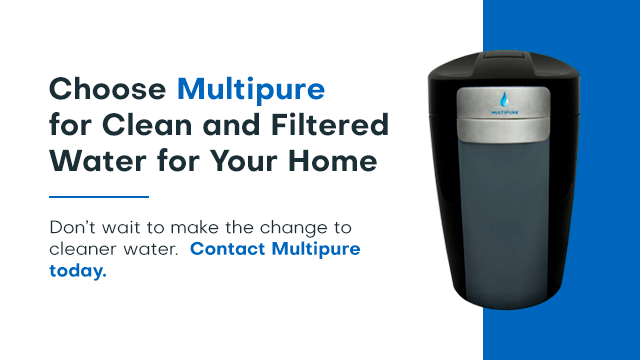Pharmaceuticals in Drinking Water: A Guide to Understanding What's in Your Glass
Posted by Kenton Jones on May 28th 2021
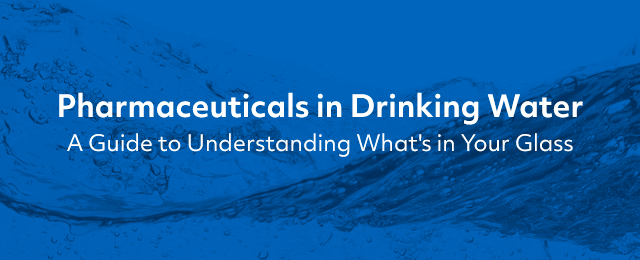
In 1999, Christian Daughton, an environmental chemist with the Environmental Protection Agency, and Thomas Ternes, who worked for Germany’s ESWE-Institute for Water Research and Water Technology,
published a journal article revealing the presence of pharmaceuticals in the freshwater cycle. Its publication sparked a flurry of attention and investigation that has continued to this day.
Additionally, in a study conducted from 2004 to 2009, the U.S. Geological Survey measured effluent samples from three wastewater treatment plants. Researchers discovered that effluents from the plants that received discharge from pharmaceutical manufacturing facilities contained prescription drug concentrations between
10 to 1,000 times higher than the concentrations in the effluent of a typical plant. The medications in the water were traceable up to 18 miles downstream from the plants and included drugs like these:
- Metaxalone, a muscle relaxant
- Oxycodone, an opioid pain reliever
- Methadone, an opioid prescribed for pain relief and drug withdrawal
- Butalbital, a barbiturate
- Phendimetrazine, a stimulant prescribed for obesity
- Carisoprodol, a muscle relaxant
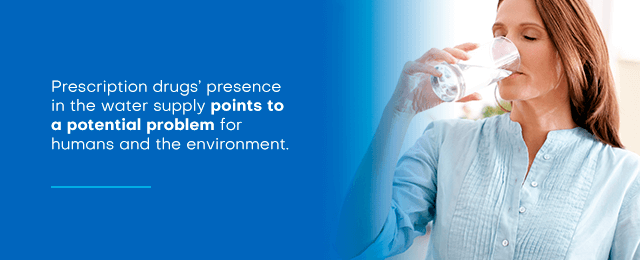
It exposes people to medicines they don’t need and endangers our ecosystem with chemicals that can have profound environmental impacts, altering how living organisms develop and grow. Even though it’s been almost 20 years since Daughton and Ternes published their findings, research into this problem is still in its infancy. However, the urgency behind this problem is growing.
One primary reason for the developing concern is that populations in North America and Europe are aging, and they are increasingly relying on prescription drugs to address a wide variety of health issues. In other words, more people plus more medication means more reasons to worry.
Some people find it alarming that there are no regulations mandating water treatment facilities to filter pharmaceuticals out of the water supply. The EPA requires water treatment facilities to test for
nearly 90 different potential contaminants, but medicines aren’t on this list. While the federal government does not expect treatment facilities to test for pharmaceuticals, the good news is that water treatment facilities are well-equipped to filter many of these toxins out of the water supply. They typically remove anywhere from 95 to 98% of pharmaceuticals from the water supply.
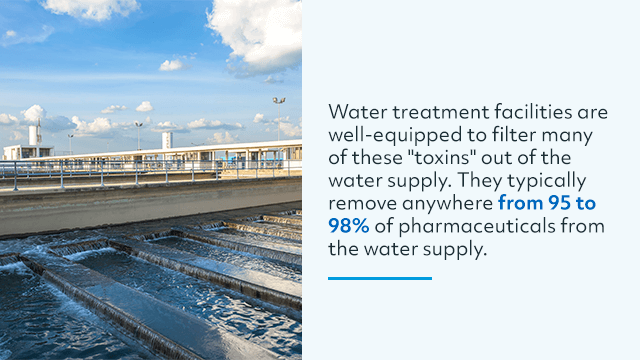
Now it’s up to additional researchers to develop a better understanding of this issue. To do this, they are asking two main questions:
- How do pharmaceuticals end up in the water supply?
- What impact are these waterborne chemicals having on the people, animals, and plants consuming them?
Why Is This Happening?
First of all, let’s define what we mean when we use the word “pharmaceuticals.” This term refers to controlled substances that doctors prescribe to humans to treat a wide range of medical conditions. So far, studies have shown that the drugs most likely to be present in drinking water include:
- Antibiotics
- Mood stabilizers
- Contraceptives and other synthetic hormones
- Blood thinners
- Heart medication
- Painkillers
One
recent study even found antianxiety and anticonvulsant drugs, as well as a beta-blocker, in tap water. Not only do prescription medications end up in the water supply, but so do over-the-counter medications, sunscreen, perfumes, lotions, and cologne.
While researchers believe the human body metabolizes about 90% of the medications people take, 10% of these drugs still end up leaving the human body and finding their way into the water supply. One of the main ways prescription drugs get into the water supply is through human waste. When you take a medication, your body metabolizes it, absorbing the parts it needs and sending the rest out in your urine or feces. Sometimes your body may sweat out the excess instead, which then washes down the drain during a shower or filters out of your clothes when you wash them.
Another primary way that pharmaceuticals end up in the water supply is through people flushing their medications. Until relatively recently, the recommendation for disposing of unused or expired prescriptions was to flush them down the toilet. When researchers discovered the chemicals from medications were lingering in the water supply, this recommendation changed, and people started finding alternative ways to dispose of their medications, primarily through pharmaceutical take-back programs or mixing them with kitty litter or coffee grounds before throwing them into the trash. However, despite the change in recommendations, many people still believe flushing is the correct way to get rid of medications, so they find their way into the water supply nevertheless.
Pharmaceuticals in the water supply can also come from landfill leachate. A 2015 study by the U.S. Geological Survey examined leachate from 22 landfills from 12 states, and every leachate sample contained contaminants of emerging concern. The study found
43 prescription pharmaceuticals in the leachate overall. For instance, about 91% of tested leachate samples contained the local anesthetic lidocaine. About 82% had carisoprodol, a muscle relaxant, and 77% contained carbamazepine, an anticonvulsant.
While water treatment facilities have the tools to deal with unwanted substances in the water supply, one challenge they face is the chemicals' changing nature. For example, in one year, there can be a significant spike in the concentration of one specific pharmaceutical compound, so the treatment is tailored accordingly. However, the next year rolls around, and there is an uptick in a different chemical. This continually changing chemical profile can be challenging for a water treatment facility because it requires continuous adaptation to the treatment plan.
The World Health Organization reports that pharmaceutical contaminant concentrations are generally
less than 0.1 micrograms per liter, or less than 0.1 parts per billion, in surface water, groundwater, and partially treated water. In treated water, those concentrations drop to less than 0.05 parts per billion.
The above-cited USGS study found concentrations as high as 3,800 parts per billion in wastewater treatment effluent near pharmaceutical manufacturing plants, and other localized areas of elevated concentration are highly likely. Primary factors in variation are likely to include the pharmaceuticals prescribed or manufactured in the area and the size of the population that uses them.
The Environmental Impacts of Drugs in Our Water
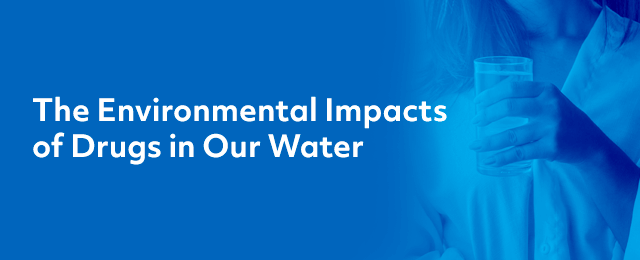
Research into how pharmaceuticals in water can impact the environment is still in its infancy — not because it isn't essential, but, as mentioned earlier, the scientific community only began to take this issue seriously in the late ’90s. However, we know we aren’t overestimating this problem's potential.
At the rates humans are using prescription-strength and over-the-counter medications, the potential for impact is multiplying. How? Let’s look at one example.
The majority of women — 72% — who use contraceptives use the hormonal variety — the pill, the patch, a hormonal IUD, or an injection. In 2014, that equated to over 9.5 million women using “The Pill,” while another nearly six million relied on other hormonal options. Hormonal contraceptives are one of the pharmaceuticals that can be present in drinking water. Even if only a tiny percentage of each dose of each woman’s medication finds its way into the water supply, those trace amounts add up to something much more significant.
And many other medications have a similar story.
When scientists find a medication in the water supply, it doesn’t stay there. If it’s in the water supply, it can impact what’s in the soil, the air, and the sediment around the area it flows through. It can also affect the wildlife in a particular region. A
recent study focused on zebrafish and the effects even low concentrations of pharmaceuticals may have on them. Scientists recreated conditions in a lab environment to expose them to specific pharmaceutical toxins. The result was a decrease in reproduction, and deformities and developmental problems in their embryos.
However, part of the problem is that detecting and treating these pharmaceuticals in the water supply isn’t as cut-and-dried as it sounds. Because pharmaceuticals are chemicals, the surrounding conditions can affect them. Final effects can depend on what other biological organisms are in the water or the soil. They can depend on how hot or cold it is outside or how much oxygen is available. All these factors can alter one single chemical's impact on the organisms it contacts.
That means there isn’t a one-size-fits-all solution to this problem. Even though initial studies have shown that pharmaceuticals are present in relatively small percentages, there isn't enough available data to determine the impact these trace amounts have on the environment. The scientific community is working to expand its body of knowledge to better protect the world we live in. We know ongoing exposure of organisms to these pharmaceuticals is affecting ecosystems. For example, studies have shown antibiotics directly impact algae and soil microbes. The steroids found in contraceptives can affect fishes', reptiles', and various invertebrates' fertility and development.
While there is a reason to believe
the presence of pharmaceuticals adversely affects the environment, scientists face challenges — particularly in being able to recreate the natural environment in their labs and studying these things over time, rather than drawing conclusions from short-term observations. So, researching more than the presence of one specific compound will be vital to understanding how pharmaceuticals interact with other chemicals to produce effects — whether good or bad — in the environment.
How Drugs in Our Drinking Water Can Affect Your Health
When it comes to pharmaceutical pollution in the water supply and its impact on human health, there’s good news and bad news.

The good news is that these chemicals are not present in our water supply in large amounts. So far, there has not been any scientific proof that these chemicals dramatically affect human health drastically. But, as we mentioned previously, several studies have shown negative impacts on fish, reptiles, and other organisms.
The bad news is that this area of research and study is still in its infancy, and no one knows how this will impact people in the long term. This evidence is enough to provide concern for humans who are using and consuming this water. Because there's no federal requirement for water treatment facilities to test for or filter out pharmaceuticals, there is no way to tell conclusively what people are ingesting over time. Knowing the side effects the pharmaceuticals in question can have on the human body when ingested in other ways, there is a high probability that they are impacting people to some degree.
Part of the issue with our exposure to drugs in drinking water lies in how prolonged and compounded it can become. One glass of water could contain several types of pharmaceutical residues that combine synergistically to create more potent hazards or
limit our ability to connect a specific contaminant to a particular adverse health effect.
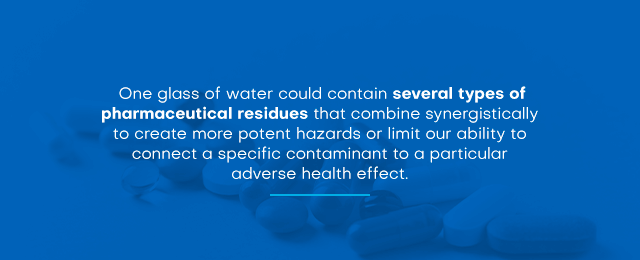
People also ingest pharmaceuticals in drinking water for years. Even though the individual amounts may be minute, they accumulate significantly over the decades. Chronic exposure over an entire lifespan could mean a person ingests hazardous levels of pharmaceuticals, even if every glass of water seems safe on its own.
There is a particular concern for the more vulnerable segments of the population, especially pregnant women, the elderly, and children. Children are especially at risk because
their bodies cannot filter toxins the way an adult body can. There is also some concern about people building up resistance to specific drugs after prolonged exposure to small amounts, even in their water.
How Can I Protect My Family?
While you shouldn’t panic over this, there are undoubtedly unwelcome elements in your tap water. What steps can you take to protect yourself and your family from drugs in drinking water and their potentially harmful effects?
1. Don't Flush Pharmaceuticals
Part of correcting a problem is committing to being part of the solution. Start by changing some of your habits when it comes to the drugs you take. Ensure you understand
how to properly dispose of your medications. Do not flush them down the toilet or wash them down the drain. Also, take steps to minimize pharmaceutical waste. Don’t buy more medicine than you can use before it expires. Ask your doctor for samples if you’re trying a new medication, rather than filling a whole prescription you may not use.
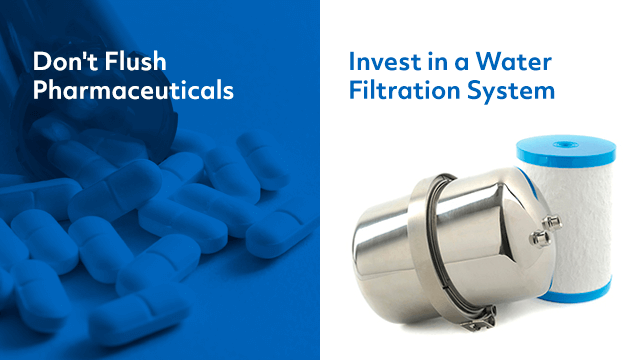
2. Invest in a Water Filtration System
Your family deserves water that is clean, healthy, and tastes great. You can enjoy all these benefits when you invest in a water filtration system designed to filter out contaminants that reside in your drinking water. By purchasing a
Multipure Drinking Water System, you can reduce the chlorine, chemicals, and other toxins in your home’s drinking water. Designed to fit either on your kitchen countertop, or below the sink — eliminating bulky bottles or pitchers — the Multipure Drinking Water System takes out the stuff you don’t want and leaves behind clean, great-tasting water for drinking, cooking, and even cleaning.
Multipure also offers
Home Essentials — filters for bathtubs and showerheads, plus options for your garden and yard. Sometimes, people assume water doesn’t have to be as clean if they're not planning to drink it — this assumption couldn’t be further from the truth. Exposure to water and the contaminants in it comes from simple tasks like showering or washing your hands. Chlorine in tap water can have a drying effect on your skin. And, when you use tap water to keep your lawn green or your roses in bloom, you’re putting those contaminants back into the ground around your home.
What's Next?
While our understanding of pharmaceuticals' impact on our water supply is still somewhat lacking, scientists generally agree that any level of exposure — no matter how small — is potentially harmful. And, while they are still working toward researching the specific effects associated with this dilemma, there’s no question you should take whatever steps you can to reduce your exposure to any unnecessary chemical or substance.
That’s where Multipure comes in. Thanks to our extensive selection of water filtration systems, our customers have discovered firsthand the benefits of having clean, filtered water in their homes — for drinking, washing, and even gardening. Water filtered through our solid carbon block filters isn't merely cleaner, but it looks and tastes better, too.
Don’t wait to make the change to cleaner water.
Contact Multipure today and let one of our representatives help you decide which of our filtering options is best for your home.
